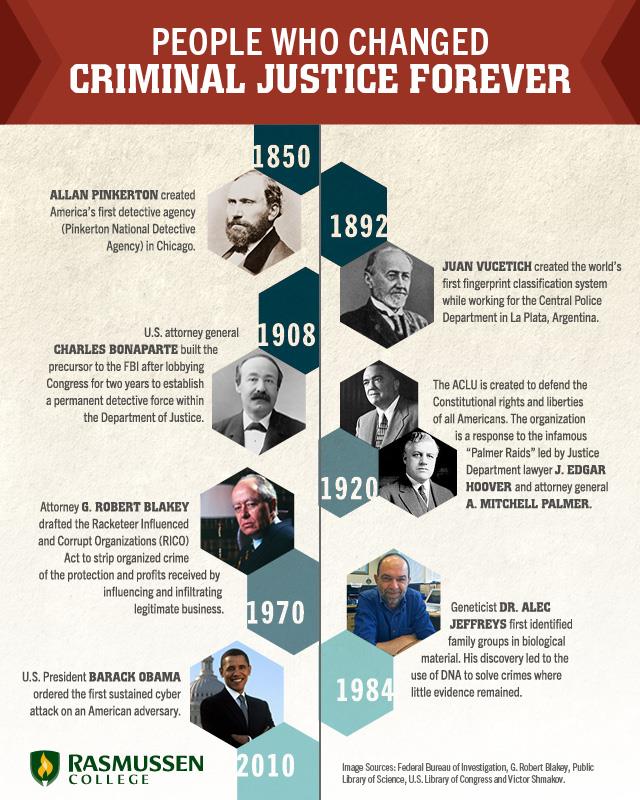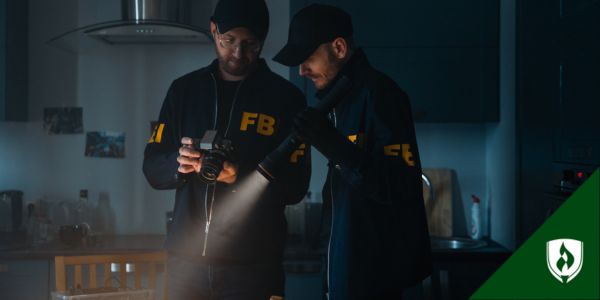History is filled with watershed moments.
Those special moments in time that make you remember exactly where you were when something important happened.
For some, it’s the assassination of John F. Kennedy. For others, it’s the explosion of Space Shuttle Challenger. Still others will always remember where they were when the World Trade Center towers fell.
The thing about watershed moments is that they’re often the harbingers of change.
The number of Secret Service agents protecting U.S. presidents in public places ballooned after JFK died. NASA overhauled its decision-making apparatus after the Challenger tragedy. And counterterrorism strategies – and funding – improved significantly post-9/11.
The field of criminal justice has seen a similar evolution.
From Wyatt Earp's shootouts with cowboys to Bobby Kennedy's war on organized crime to the invention of forensic facial reconstruction, there are moments in history that have changed the course of criminal justice forever.
It is only in hindsight that we recognize the importance of these moments. And only through reflection that we appreciate the myriad trails they blazed.

1850: First detective agency founded
- History: Allan Pinkerton created the Pinkerton National Detective Agency in Chicago, Ill., in 1850. He received national recognition after uncovering a plot to assassinate Abraham Lincoln in 1861. He also helped organize a federal secret service during the Civil War and eventually rose to become its chief.
- Today: Pinkerton was acquired by Sweden’s Securitas AB in 1999. After acquiring six other American security firms, Securitas AB became Securitas Security Services USA, the world’s largest private provider of security services.
1861: First parole system created
- History: First in 1861 and again in 1877, Zebulon Brockway implemented the concept of “indeterminate sentencing,” or parole, while serving as warden of the Detroit House of Corrections and the Elmira Reformatory (N.Y.), respectively. Brockway lobbied the New York Prisons Association to abandon “time sentences” for “reformative” ones that focused on rewardinginmates with shortened sentences for evidence of reform, rehabilitation or notable good behavior, according to Samuel Barrows’ report The Indeterminate Sentence and the Parole Law.
- Today: By the end of 2011, almost seven million people were under some form of adult correctional supervision, according to the Bureau of Justice Statistics. That number translates to about 2.9 percent – or one in 34 inmates – of the entire prison population of the U.S.
1892: First use of fingerprints to solve a murder
- History: While working for the Central Police Department in La Plata, Argentina, Juan Vucetich created the world’s first fingerprint classification system – based on early experiments by English scientist Sir Francis Galton. Vucetich referred to his system as “comparative dactyloscopy,” and used it in 1892 to identify a bloody fingerprint found at the scene of a gruesome double-murder of two children. The children’s mother admitted to the killings after presented with the evidence against her.
- Today: In 1892, Vucetich’s system identified 101 different fingerprint patterns. Today, the FBI’s Integrated Automated Fingerprint Identification System (IAFIS) is considered the biggest biometric identification system in the world – housing the fingerprints of more than 103 million domestic subjects and 73,000 known and suspected terrorists from around the world.
1908: First U.S. policewoman hired
- History: With more than 1.5 million visitors expected to descend upon Portland (Ore.) for the 1905 Lewis and Clark Exposition, officials contracted the Portland YWCA and Lola G. Baldwin to establish a traveler’s aid program. The program was designed in part to protect unsuspecting women from what officials called the “inevitable con men, pimps and other criminals” attracted to the fair. Baldwin was paid $75 dollars a month during the four-and-half month event and was given arrest authority. She recruited volunteers from Portland’s women’s clubs to provide surveillance of the 400-acre fairgrounds. She was officially sworn in as the nation’s first paid policewoman in 1908.
- Today: There are more than 110,000 female police officers across the United States, according to the U.S. Census Bureau.
1908: FBI predecessor created
- History: While serving as U.S. attorney general in 1906, Charles Bonaparte began lobbying Congress for a permanent detective force within the Department of Justice. Bonaparte argued for a team of hand-picked “special agents” who could investigate perpetrators of timber and land fraud, involuntary servitude and “crimes against the Treasury.” An act of Congress in 1908 created the Bureau of Investigators with 25 special agents and a mandate to find and bring to justice violators of federal laws.
- Today: The Bureau of Investigation became the Bureau of Law Violation Investigators in 1908 and, in 1911, the Federal Bureau of Investigation. As of September 2012, the FBI employed almost 14,000 special agents and more than 22,000 support professionals.
1920: ACLU formed
- History: The American Civil Liberties Union (ACLU) is a non-profit, non-partisan organization that was created to defend the Constitutional rights and liberties of all Americans. Well-known pacifist and author Roger Nash Baldwin, alongside feminist lawyer Crystal Eastman and law professor Walter Nelles, are credited with founding the organization in 1920. The ACLU was formed in response to the Palmer Raids. The aim of the raids was to simultaneously arrest thousands of anti-war protesters – referred to as “suspected anarchists and radicals” by J. Edgar Hoover and attorney general A. Mitchell Palmer. After holding the suspects without charging them and questioning them without representation, the FBI began deporting those with ties overseas.
- Today: The ACLU has become the nation's largest public interest law firm. It has grown to more than 500,000 members with a 50-state network of staffed, autonomous affiliate offices. Around 100 ACLU staff attorneys collaborate with 2,000 volunteer attorneys to handle close to 6,000 cases annually.
1923: Interpol created
- History: Dr. Johannes Schober – president of the Vienna (Austria) police force at the time – created the International Criminal Police Commission (ICPC) between Czechoslovakia, Poland, Austria, Belgium, China, Egypt, France, Germany, Greece, Hungary, Italy, the Netherlands, Romania, Sweden, Switzerland and Yugoslavia. The organization adopted the moniker INTERPOL – a contraction of the words “international police” – in 1946 and its official flag in 1950.
- Today: Based in Lyon (France) Interpol serves as the intelligence and communications liaison for police forces across its 190 member countries. Operating with an annual budget of around €60 million, Interpol provides targeted training, investigative support and real-time data to help combat a wide variety of criminal activity across international borders.
1970: RICO Act drafted
- History: The Racketeer Influenced and Corrupt Organizations (RICO) Act was enacted as part of the larger Organized Crime Control Act of 1970. It was drafted by G. Robert Blakey to strip organized crime of the protection and profits it received by influencing and infiltrating legitimate business. The RICO Act changed the game for law enforcement because, for the first time, the leaders of a crime organization could be punished for orders they gave subordinates. No longer could a mafia boss insulate himself from legal punishment simply because he wasn’t physically present when the crimes occurred. Originally written to allow prosecutors to go after the American mafia, RICO has been expanded and applied to several high-profile cases unrelated to organized crime.
- Today: Between 1970 and 1985, just 300 civil RICO suits were filed in federal court. That number grew to 614 in 1986 and 957 two years later. Now, the number of RICO civil cases filed is well over a thousand per year, says Washington D.C. attorney Jol A. Silversmith on his blog Third Amendment.
1984: DNA first used for biological identification
- History: In September 1984, University of Leicester geneticist Dr. Alec Jeffreys found what he called “a horrible, smudgy, blurry mess” on a slide containing biological material from his assistant, Jenny Foxon. After studying the sample closer, he identified a family group in the sample and realized he could distinguish all three members of Foxon’s family by a simple pattern of inheritance. Jeffreys first used the technique in April 1985 to solve a complex immigration issue that ultimately reunited a young boy from Ghana with his family in England. In 1986, Jeffreys used DNA to arrest and convict a suspect who raped and murdered two schoolgirls three years apart.
- Today: As of December 2012, the National DNA Index (NDIS) contains more than 10 million offender profiles, 1.3 million arrestee profiles and 467,000 forensic profiles, according to FBI statistics. The primary metric used to determine the effectiveness of the NDIS is the number of investigations the database has helped. As of December 2012, the Combined DNA Index System (Codis) has produced more than 198,000 hits and assisted in 190,500 investigations.
2010: First government-sanctioned use of sustained cyberwarfare
- History: A highly sophisticated computer worm was found in June 2010 to be targeting five of Iran’s nuclear facilities. The Stuxnet virus was designed destroy centrifuges used to enrich uranium at the Iranian facilities. The New York Times reported in a June 2012 story that President Obama acknowledged ordering the Stuxnet attack as a continuation of a George W. Bush strategy to sabotage Iran’s nuclear program. The U.S. reportedly collaborated with Israel on the attack. Stuxnet spread through Iran for a full year before being discovered in 2010, according to Mikko Hypponen, chief researcher at computer security provider F-Secure. He also said the worm would likely have taken “10 man-years” to write due to the complexity of the code. Stuxnet appears to be the first time a government has sanctioned a sustained cyber attack on the infrastructure of one of its adversaries.
- Today: In May 2012, computer security researchers from Iran, Hungary and Russia jointly discovered “Flame,” a new piece of malware targeting Iran’s oil fields. One of the Hungarian researchers called it “the most complex piece of malware ever found.” The Washington Post reported in June 2012 that the Flame malware was a product of U.S.-Israeli cooperation and that it contains elements identical to some found in Stuxnet.
From the FBI and fingerprints to DNA and digital warfare, the basic code of law enforcement – i.e., “to protect and serve” – has changed dramatically. All of the milestones mentioned above have one thing in common: they broke new ground in law enforcement. In doing so, they changed the course of criminal justice forever.
Related Articles:




